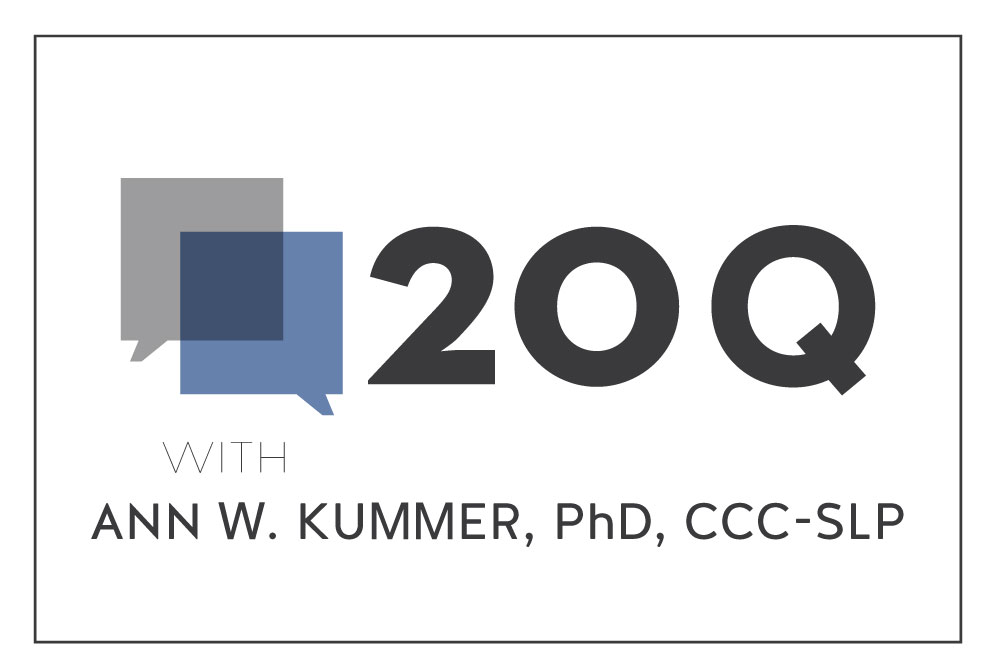From the Desk of Ann Kummer

From the desk of Ann Kummer…
When I was working at Cincinnati Children’s Hospital Medical Center, all clinical providers were required to take a course on patient-centered care and motivational interviewing. As a result of this training, we dramatically changed the way we approached our speech-language pathology practice, especially the way we determined goals of treatment. We found that the changes that we made enhanced participation of the patient in therapy and increased the rate of achieving goals. Because I am such a fan of these counseling techniques in determining treatment goals, I’m particularly happy that Heather Koole and Sarah Baar agreed to do this article.
Heather Koole, PhD, CCC-SLP is associate professor in the Speech Pathology and Audiology Department at Calvin University in Grand Rapids, MI. The combination of Heather’s undergraduate and graduate degrees (social work, speech-language pathology, interdisciplinary health sciences) and clinical work have propelled her to think broadly about issues in the field of communication sciences and disorders. Her research and teaching interests include the following: how people with communication disorders (particularly brain injury) experience success and participate in life in meaningful ways; effective ways for preparing students to support clients in that success; facilitators and barriers to the SLP’s role in providing functional and contextualized intervention.
Sarah Baar is a speech-language pathologist in Grand Rapids, MI. She’s had the opportunity to work in many settings across the continuum including acute care, acute rehab, home & community, outpatient therapy, and private practice as well as being involved in various leadership projects. In 2016, she started the Honeycomb Speech Therapy website as a way to promote person-centered and functional therapy ideas and materials for adult rehab. Clinical SLPs enjoy her practical approach and tips that the everyday SLP can implement for a functional therapy approach.
This article describes the philosophy of determining meaningful goals for each patient, which is an essential part of person-centered care. This article also provides tools to help with understanding a client’s needs and preferences. Specific counseling techniques and examples within therapy interactions are shared. I think you will appreciate the focus of this article and learn from it.
Now…read on, learn, and enjoy!
Ann W. Kummer, PhD, CCC-SLP, FASHA, 2017 ASHA Honors
Contributing Editor
Browse the complete collection of 20Q with Ann Kummer CEU articles at www.speechpathology.com/20Q
20Q: Setting Meaningful Goals with Your Clients: How Counseling Techniques Can Help
Learning Outcomes
After this course, readers will be able to:
- Identify meaningful needs that align with a person-centered approach.
- Describe ethnographic counseling techniques that support understanding how the world looks to our clients.
- Describe motivational interviewing techniques that support a client to feel understood.


1. What is person-centered care?
Person-centered care is a philosophy within healthcare that centers decisions and care around a client’s needs, preferences, values, and experiences. It recognizes that each individual is an expert on what matters to them! You can see that by the very definition, person-centered care can’t be scripted or a 1-size-fits-all approach. This contrasts with the formerly emphasized medical model, which focuses on client impairments and positions the medical provider as the ultimate decision-maker. Implementing person-centered care in a medical model environment can be difficult at times. Our discussion will focus on sharing tools and ideas that support person-centered practices, specifically to guide speech-language pathologists (SLPs) in understanding client needs, preferences, and values in order to set meaningful goals.
2. How does person-centered care impact the type of goals we have in therapy?
Traditionally, our profession has been narrowly focused on impairment-based goals in therapy, as a result of the medical model philosophy (e.g., The patient will recall +⅘ unrelated words after a 5-minute delay). Those goals don’t exactly describe the needs a client would have for him/herself. Person-centered care allows us to reimagine our role in therapy, with the overarching goal of impacting someone’s life participation. This significantly impacts the way we write goals because goals will link to real life and reflect the client’s preferences and needs (e.g., The patient will recall the passcode to access a cell phone, using training and supports, on 90% of attempts within a therapy session).
3. What have clients told us about addressing “meaningful needs” in speech therapy?
Individually, as SLPs, many of us have had the experience of a client wondering, “What does this have to do with anything,” when a task or goal in speech-language therapy is focused only on an impairment. As I’ve learned, I see now that the client may be indicating that values or preferences aren’t being reflected or understood. Interestingly, population-specific research gives us a similar message, no matter which population we look at (e.g., aphasia, mild cognitive impairment, motor speech). Clients have politely let us know that:
- SLPs need to focus on activity/participation within goal-setting (Worrall et al., 2011).
- SLPs need to focus intervention on participation situations relevant to the client (Yorkston, Baylor, & Britton, 2017).
- SLPs need to talk about improvements in terms of everyday life; this matters more than any test score improvement (Smith, et al., 2018).
4. What information do we need from our assessments in order to accomplish the overall goal of real-life meaningful change?
In a nutshell, we need to know what’s important to our clients. As Helm-Estabrooks, Albert, and Nichols (2014) discussed, our job includes discovering our client’s current communication abilities as well as their communication wants and needs so that we can close the gap between the two. Data we collect about cognitive and linguistic skills are meaningless without knowledge of how impairments in those areas impact our client’s ability to participate in life in a way that brings them joy and fulfillment.
5. How can we make sure we consider the whole person when completing our assessment?
Traditional assessment procedures give us plenty of impairment-level information, which is necessary but not sufficient. To discover the real-life impact of our client’s impairments we must consider all domains of health. Kagan and Simmons-Mackie (2007) described these four overlapping domains of their AFROM model: impairment, environment, participation, and personal identity. If we make sure our assessment procedures probe all four of those domains (instead of only the impairment domain), we’ll get much more than data about deficits and task performance. We’ll find out what matters to our clients in their real lives!
6. What tools can help us understand a client’s goals from their perspective?
There are established tools available for us to use within our first meetings with a client that can help us understand their perspective and goals for the therapy time we share. These types of tools include needs-based questionnaires (e.g., Functional Needs Checklists from Honeycomb Speech Therapy), patient-reported outcome measures (e.g., Communication Participation Item Bank, Baylor et al., 2013), rating scales (e.g., Patient Competency Rating Scale, Kolakowsky-Hayner, S., 2010), and evidence-based counseling techniques (the focus of the rest of this discussion). It’s compelling that the words we choose and how we use them can help uncover meaningful goals for our clients, and ultimately impact the effectiveness of our therapy time.
7. Tell me more about how counseling techniques relate to understanding a client’s goals.
Sometimes counseling can seem a little “fuzzy.” ASHA includes counseling in our scope of practice and research has shown that therapeutic alliance is a factor in the effectiveness of our therapy. But what are we really talking about? Holland & Nelson (2020) define counseling as a listening process that involves four tasks:
- Trying to understand how the world looks to our clients
- Encouraging our clients’ expression
- Advising
- Helping our clients translate information into action
We often focus on the “advising” and “translating information into action” tasks while neglecting the other two. Understanding how the world looks to our clients and encouraging their expression are trickier, but they’re critical if we’re going to help our clients set meaningful goals and achieve real-life change.
8. What are some counseling techniques we could use in speech therapy to help understand a client’s goals?
Two techniques that can help us are ethnographic interviewing and motivational interviewing. Although there’s overlap between them, we’ll highlight basic components from each that reflect their unique contributions.
9. Tell me about ethnographic interviewing and how it’s useful.
Ethnographic interviewing is based on social research practices and is often used in other fields (e.g., social work). It has been adopted in our field as a way to find out what the world looks like to our clients and their families. Ethnographic interviewing provides a culturally responsive method for clinicians to engage with clients that results in understanding and empowerment. Multiple experts in our field have written about its clinical use. Two resources that we like include the ASHA Leader article, Asking the Right Questions in the Right Way, by Westby, Burda, and Mehta (2003), and Hyter and Salas-Provance’s (2019) textbook Culturally Responsive Practices.
10. What’s the difference between traditional interview questions and ethnographic interviewing?
In traditional interviews, the clinician is positioned as the expert who directs what the client talks about. Ethnographic interviewing allows the client to be the expert (about their life), giving them the lead in choosing what’s important to explore in the interview. The clinician is still the expert in speech-language content but moves away from an “I know what’s best” stance (Westby, Burda, & Mehta, 2003) toward a posture of genuine curiosity about their client’s life experience.
11. So what kinds of questions could I ask?
Westby, Burda, and Mehta (2003) and Hyter and Salas-Provance (2019) outlined five types of descriptive questions to use in ethnographic interviewing:
- Grand tour questions get at a client’s broad experience. (e.g., Tell me what a typical day looks like for you at work.)
- Mini-tour questions get at a specific experience or event within the broader experience. (e.g., Tell me about your weekly sales department meetings.)
- Example questions dig deeper into an experience by asking for an example. (e.g., Give me an example of what you said during the meeting that made your boss angry.)
- Experience questions focus on the experience of an event versus the details of the event. (e.g., Tell me what it’s like to work with your boss)
- Native language (or clarifying) questions uncover what your client means by the words/phrases they use. (e.g., What does “trying as hard as I can” look like for you?)
12. Tell me about Motivational Interviewing and how it’s useful.
Motivational Interviewing is an interaction style that has evidence for supporting goal-setting and facilitating motivation for change. Although it doesn’t originate in the rehab world, it’s been thought to be a good fit for rehabilitation because of the person-centered approach. Motivational Interviewing involves intentionally phrasing your comments and questions in therapy through Open-Ended Questions, Affirmations, Reflections, and Summaries. Our deliberate wording choices allow the patient to experience empathy, feel heard, and internally become ready to commit to changes and know why they want to make those changes.
13. How could I use open-ended questions in the assessment?
During the assessment and goal-setting process, choosing to avoid simple yes/no or leading questions may be helpful. (Example of what not to say: “You’re having memory difficulty, aren’t you?”) By phrasing a question/statement in an open-ended manner, we allow the client to take the response in the direction that is important to them. Here are some examples:
- What’s most important for us to talk about today?
- What information would be helpful for you?
- What’s going well at home?
- Describe a typical day.
- What might your life look like if you were at a point where you didn’t even need speech therapy?
- If you could pick one thing that would be better in the next week, what would it be?
14. How could I use reflections in the assessment?
Studies have shown that we need to do more reflections as SLPs. These statements are important in letting a client know that you are really listening - and they are heard and understood. These statements can be as simple as rephrasing what the client said, or more complex by adding meaning while rephrasing what the client said. When a client feels understood, they will expand and offer more information, which helps you better understand their needs. Here are some examples:
- You are feeling angry that therapy has been recommended by your doctor.
- You are feeling emotional about how difficult things have been at home.
- You are concerned with being able to commit to speech therapy appointments, and you’re also concerned with being able to get back to managing your home and medications and finances.
- You are feeling frustrated about how slow progress has been.
- It sounds like you want to be doing more social outings, but don’t feel confident to go out to eat like before.
- You’re noticing that you’ve misplaced your keys or coffee mug, but it’s not really bothering you.
15. How could I use affirmations in the assessment?
Affirmations allow us to recognize the client’s skills or appreciate them in a genuine way. An affirmation highlights strengths and facts in a way that differs from a compliment. Using affirmations helps support a client’s ability to believe in themselves - or increase their sense of self-efficacy - which is necessary to continue making changes.
- I see you working so hard on this, and even though it’s hard, you are giving it your full effort every time.
- You care so much for your spouse, and you’re taking a lot of information into consideration; that can be tricky, and I see you are being thoughtful about it.
- You’re in the middle of different opinions from other family members, I can respect that navigating that is not easy, and it’s okay to take 1 day at a time.
- There’s no question that you are a resilient person - I can tell that you’ve dealt with a lot in your life, and this is another example of how resilient you are.
16. How could I use summaries in the assessment?
A summary is a way of consolidating a discussion in an intentional way. The point of summarizing what has been discussed is to highlight positive aspects, link ideas, promote strengths, and move the discussion forward. Here are some examples:
- We’ve spent time talking about your history, including the things that really matter to you like xxx. These are things we can address in speech therapy.
- I hear you saying that you’ve experienced a lot of progress in the past month, and you are willing to keep working so that you can return to driving.
- What you’re describing is that you aren’t sure what goals you’ve had in earlier therapies, but ultimately you want to return home, so you may be willing to participate with the goal of getting back home.
- So, to summarize: You haven’t enjoyed the speech therapy tasks you did in inpatient rehab, and you still have goals that you want to improve for how things are going at home before you return to work. You’re hoping that in our time together we can work on those exact things, and you’re absolutely right - that’s what we can do together in speech therapy.
17. What can I ask if I don’t have a lot of time?
You can think of your interviewing as an ongoing conversation with your client. It’s ok (and beneficial!) to continue the questions and conversation over the course of your sessions. Too many questions too quickly can be overwhelming. Try starting with a grand tour question followed by a mini-tour question. Ask your client a question that will establish that you’re interested in how the world looks to them. Here’s another way to think about it: If you don’t take the time to ask the questions now, your time won’t be used as efficiently or effectively later.
18. What if my client can’t talk?
It can be difficult to elicit input from our clients when they have significant communication impairments such as severe aphasia. The Life Interest and Value (LIV) cards (Haley, Womack, Helm-Estabrooks, Caignon, & McCulloch, 2007) are a helpful tool for clinicians to engage with their clients in a productive discussion about goals. The black and white drawings of life activities can be used within sessions to elicit the client’s input. There’s a temptation to rely on caregiver input (“proxy reports”) for client goals, but research has shown that having a caregiver “speak for” a client doesn’t result in accurate reflections of the client’s desires.
19. Is it ok to “only” work on specific functional activities? Or what the client wants to do?
Shifting therapy time to address a specific functional activity feels a lot different than the common “train and hope” approach where you do a little of everything and keep your fingers crossed that it makes a difference. The bottom line is that a small improvement in impairment-based testing does not necessarily mean that someone’s participation will improve. In fact, studies have shown the opposite to be true: Clients have reported improved quality of life associated with increased participation in desired activities even when the impairment itself doesn’t change. With this in mind, it is absolutely okay to focus on specific activities that can be used again and again to impact someone’s life. Consider the example of working with someone to introduce themself at an assisted living. They will continue to have more interaction opportunities with this activity practiced directly. We recommend reading more about this topic in Dr. Hinckley’s 20Q.
20. What if my client says they don’t have any goals?
As we strive to center our clinical decisions around a client’s needs, preferences, values, and experiences, a common challenge will be those clients who don’t quickly express goals. Here are some ways that we have found helpful to think about these instances:
- Pause to ask yourself: Have I provided the right tools to support making a choice? In a study with people with dementia, it was suggested that adding picture and/or text supports helps elicit preferences (Burshnic & Bourgeois, 2020), even for those with severe dementia. The LIV cards we mentioned above are another great option for supporting communication and eliciting client input.
- Next, many clients aren’t going to be able to list their own goals when you ask them in an open-ended way. In those situations, consider switching to a semi-structured interview (Dutzie et al., 2019) which can be a helpful method to elicit preferences and goals. (ex: Tell me about how ordering your meals is going.)
- Many clients aren’t going to be able to list specific goals when you ask it in an open-ended way using generic “SLP lingo.” We’ve all had clients who just shrug their shoulders in response to questions like “What do you want to work on?” or “What are your therapy goals?” Consider switching to an ethnographic interview question that helps your client describe what “doing better” might look like for them. (e.g., If you were feeling better about things, what would I see you doing?) Or try asking a semi-structured interview question (Dutzie et al., 2019) to elicit their thoughts about specific activities they’d like to be able to do. (e.g., Tell me two things that you wish weren’t so hard for you to do.) If they respond with something very broad (e.g., “numbers” or “go back to normal”) keep probing with your ethnographic questions. (e.g., “Tell me some things you like to do that use numbers” or “Give me an example of something you would do if you were “back to normal.”)
- Another idea is to think through specific categories related to your client’s daily experiences that – if adjusted – could have a wide-reaching impact on their quality of life. One such category is social connection, which has been linked over and over to health outcomes. Because we have adopted a person-centered and holistic view regarding our role in speech-language therapy, activities involving social connection are appropriate needs to think through for those who don’t express goals.
- Another category that’s wise to think through in the spirit of a holistic approach is safety needs. Can your client use the call light? Do they remember to lock their door at home? The specific safety needs will be personalized to each client’s situation.
- The last category we encourage you to think through is opportunities for autonomy. Does your client have authentic opportunities to make choices during their day? Often, we find that occasions for real decision-making can be better developed with supports and education through speech-language therapy.
References
Baar, S. (2020). Discovering functional needs in speech-language therapy. In A. Holland & R. Elman (Eds.), Neurogenic Communication Disorders and the Life Participation Approach: The Social Imperative in Supporting Individuals and Families, (pp. 52-79). Plural Publishing.
Baylor, C., Yorkston, K., Eadie, T., Kim, J., Chung, H., & Amtmann, D. (2013). The communicative participation item bank (CPIB): Item bank calibration and development of a disorder-generic short form. Journal of Speech, Language, and Hearing Research, 56, 1190–1208.
Burshnic, V.L., & Bourgeois, M.S. (2020). A seat at the table: Supporting persons with severe dementia in communicating their preferences. Clinical Gerontology, 45(3), 647-660. https://doi: 10.1080/07317115.2020.1764686
Dutzi, I., Schwenk, M., Kirchner, M., Bauer, J. M., & Hauer, K. (2019). "What would you like to achieve?" Goal-setting in patients with dementia in geriatric rehabilitation. BMC Geriatrics, 19(1), 280. https://doi.org/10.1186/s12877-019-1296-7
Jesus, T. S., Bright, F., Kayes, N., & Cott, C. A. (2016). Person-centered rehabilitation: What exactly does it mean? Protocol for a scoping review with thematic analysis towards framing the concept and practice of person-centered rehabilitation. BMJ open, 6(7). https://doi.org/10.1136/bmjopen-2016-011959
Jesus, T. S., Papadimitriou, C., Bright, F. A., Kayes, N. M., Pinho, C. S., & Cott, C. A. (2022). Person-centered rehabilitation model: Framing the concept and practice of person-centered adult physical rehabilitation based on a scoping review and thematic analysis of the literature. Archives of Physical Medicine and Rehabilitation, 103(1), 106–120. https://doi.org/10.1016/j.apmr.2021.05.005
Haley, K.L., Womack, J.L., Helm-Estabrooks, N., Caignon, D., & McCulloch, K.L. (2010). The Life Interest and Value Cards. Chapel Hill, NC: University of North Carolina Department of Allied Health Sciences.
Helm-Estabrooks, N., Albert, M. L., & Nicholas, M. (2014). Manual of aphasia and aphasia therapy (3rd ed.). Pro Ed.
Holland, A. & Nelson, R. L. (2018). Counseling in communication disorders: A wellness perspective (3rd ed.). Plural Publishing.
Honeycomb Speech Therapy Activity Studio. “Motivational Interviewing.” Retrieved May 2022 from: https://honeycombspeechtherapy.com/activity-collection/motivational-interviewing/
Hyter, Y.D. & Salas-Provence, M. (2019). Culturally responsive practices in speech, language, and hearing sciences. Plural Publishing.
Kagan, A., Simmons-Mackie, N., Rowland, A., Huijbregts, M., Shumway, E., McEwan, S., Threats, T., & Sharp, S. (2008). Counting what counts: A framework for capturing real-life outcomes of aphasia intervention. Aphasiology, 22(3), 258-280.
Kolakowsky-Hayner, S. (2010). The patient competency rating scale. The Center for Outcome Measurement in Brain Injury. https://www.tbims.org/combi/pcrs
MacFarlane, L. (2012). Motivational interviewing: Practical strategies for speech-language pathologists and audiologists. Canadian Journal of Speech-Language Pathology and Audiology, 36(1), 8-16.
Smith, G. E., Chandler, M., Fields, J. A., Aakre, J., & Locke, D. E. (2018). A survey of patient and partner outcome and treatment preferences in mild cognitive impairment. Journal of Alzheimer’s Disease, 63(4), 1459–1468.
Yorkston, K., Baylor, C., & Britton, D. (2017) Speech vs speaking: The experiences of people with Parkinson’s Disease and implications for intervention. American Journal of Speech-Language Pathology, 26, 561-568.
Westby, C.E., Burda, A., & Mehta, A. (2003). Asking the right questions in the right ways: Strategies for ethnographic interviewing. ASHA Leader, 8, 4-17.
Worrall, L., Sherratt, S., Rogers, P., Howe, T., Hersh, D., Ferguson, A., & Davidson, B. (2011). What people with aphasia want: Their goals according to the ICF. Aphasiology, 25(3), 309-322.
Citation
Koole, H. & Baar, S. (2022). 20Q: Setting Meaningful Goals with Your Clients: how counseling techniques can help. SpeechPathology.com. Article 20520. Available at www.speechpathology.com


